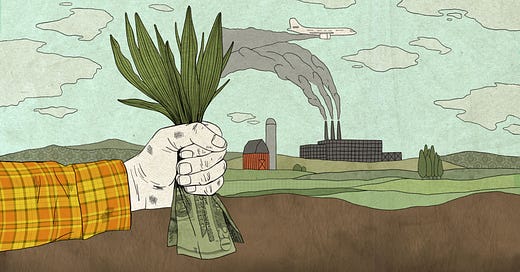To help incentivize conservation practices, new companies like Nori and Regen Network have cropped up to connect responsible producers to carbon credit opportunities. Farmers can now get paid for a range of regenerative practices, including cover cropping, no-till, adaptive multi-paddock grazing, reducing synthetic inputs, conserving grasslands, and other methods that improve soil organic carbon (SOC) stocks. At the government level, the US Senate recently passed the Growing Climate Solutions Act, which puts the Department of Agriculture in charge of assessing the efficacy of nature-based climate solutions (NCS) and regulating these new ecosystem system services markets. Meanwhile, the international ‘4 per 1,000’ initiative, launched by France in 2015, aims to increase the amount of carbon in the soil of crops- and rangelands by 0.4 percent per year.
But as states and nations prepare to incentivize NCS, barriers still exist for interested landowners. Groups like the World Resource Institute have expressed their concerns about the potential of regenerative agriculture to mitigate climate change because of its site-specific benefits and history of flawed carbon accounting. Therefore, soil carbon projects must depend on reliable monitoring, reporting, and verification (MRV) protocols to generate credits that represent real net GHG reductions. Without completing this step, there is no way for NCS project developers to comply with the standards set by regulatory agencies like BCarbon, Verra, Climate Action Reserve (CAR), and participate in carbon markets. However, quantifying regenerative agriculture is a challenge.
Dry combustion, the traditional method for assessing SOC, is no simple task. Agronomists traverse across acres of land to obtain soil samples on-site before mailing them to a lab where a scientist burns the soil to determine the carbon. Not only does this approach take months or years to plan and execute, but it is also labor-intensive, expensive, and relies on specialists, making it impractical for the everyday farmer. And because dry combustion only provides a snapshot of data for a particular time and farm plot, it has to be repeated every few years, adding to the total cost of a carbon project. Thus, to unlock the power of agricultural soils to draw down carbon, we need accurate, cost-effective, and accessible ways to determine and predict with confidence how our management of ecosystems will affect future soil carbon content.
With this in mind, companies like Yardstick and Hone Carbon are creating the next generation of hand-held spectrometers (probes) to track soil carbon levels onsite, without the need to dig up a sample and ship it to a lab. Both technologies hold the potential to unlock carbon sequestration through real-time, in-field measurements that rely on spectral analysis, resistance sensors, machine learning, and agricultural statistics. Meanwhile, startups including Seqana (formerly CQuest), Boomitra, Cloud Agronomics, and ReGrow are looking beyond ground field visits to see if we can monitor changes in SOC from satellite images - otherwise known as remote-sensing. And by combining artificial intelligence with hyperspectral images, complex carbon models can better deal with the fluctuation in soil characteristics across large areas - at a fraction of the cost.
In addition to reducing costs, remote-sensing offers a reliable approach to reduce the three most common concerns surrounding NCS: permanence, leakage, and additionality. By analyzing past, present, and future satellite imagery, regulators can see the duration of a project, how it has evolved, and if it is discontinued. When paired with social data, satellite imagery can assess local leakage by observing changes in land use around the project area. And because satellite imagery can help establish a baseline, regulators can measure additionality to help determine whether conservation practices would have been adopted without the help of carbon financing.
Done right, these efforts could scale up the soil building rather than soil supplementing practices that ecologists have hoped farmers would adopt for years. By monetizing regenerative farming and grassland conservation practices that store reliable rates of carbon, we have a chance to achieve global emission-reduction goals while providing a better livelihood for millions of farmers across the globe. As it stands, emerging agricultural technologies are making it easier than ever for landowners to implement regenerative practices over large swaths of land. But before the soils of the world can become a mainstream mitigation strategy, a credible and cost-effective MRV system for SOC is essential for widespread assessment of practices and outcomes. If this sounds like something you are working on, get in touch!






*any feedback
Very crisp and articulative.These MRV startups https://boomitra.com ,https://www.regrow.ag , what you say , ant feedback . thanks